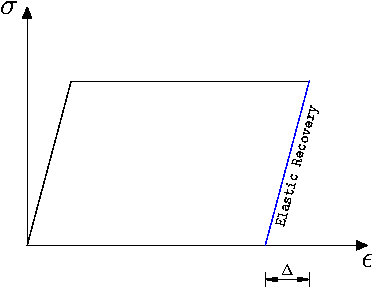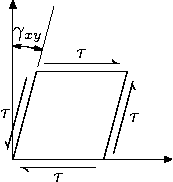Strength of Materials/Introductory Concepts
Strength of Materials in Engineering Mechanics
Introduction | Introductory Concepts | Loading of Beams | Torsion | General State of Stress | Weakest link determination by use of three parameter Weibull statistics
next →
Stress[edit | edit source]
Stress is defined on the average as the force divided by the area of the body over which the force acts. More precisely, we can talk about a stress at a point, or simply a stress, in the limiting case where the area (an infinitesimal area dA) approaches zero. The normal stress occurs due to the infinitesimal force normal to the infinitesimal area, while shear stresses occur due to the infinitesimal force in the plane of the infinitesimal area. (Note: strictly speaking, stress does not exist. Elongation () and stiffness (E) do. Stress is a convenient mathematical construct that allows easy manipulation of formulae)
Consider a force, dF, acting on an elemental area, dA, at any arbitrary angle. τxx = dFx/dA is the normal stress, also denoted as σx. The shear stresses are given by τxy = dFy/dA and τxz = dFz/dA, where dFy and dFz are the y and z components of force dF respectively. These shear stresses are in the plane y-z.
Now, instead of an infinitesimal area, consider an infinitesimal volume at the point in question. Let this volume be a parallelepiped with the sides dx, dy, and dz. In this case there are, in general, nine non-zero stresses. They form a stress tensor represented by the following 3x3 matrix.
Accordingly, in the plane stress case (taking, for instance, the plane x-y) we will have a four component stress tensor. Further, in view of the shear stress symmetry (τxy = τyx = τ), the above 3x3 matrix reduces to the 2x2 symmetric matrix representing a symmetric plane stress tensor.
The shear stress symmetry holds in the three-dimensional case. This makes the above 3x3 matrix--and hence the corresponding stress tensor--symmetric: only three of its six shear stress components are independent ones. Consequently, the stress tensor has in general six different components: three normal stresses and three shear stresses. As already shown above, in the two-dimensional case the stress tensor has only three different components: two normal stresses and one shear stress.

Suppose the body is in equilibrium and is acted upon by the forces fx and fy (per unit volume) in the x and y directions respectively.
It then can be shown that the stress equilibrium equations, in Cartesian coordinates, has the form:
Thus, in the plane stress case, we have two equations involving three unknowns.
Now turn to an example of the simplest one-dimensional loading of a body. Consider a rod, pulled at each end, along the longitudinal axis.
If we take a section perpendicular to the axis, it is easy to see σx = P/A where P is the load and A is the cross sectional area of the section.
Now consider the case where the cross section is angled θ with respect to the longitudinal axis.
In this case, we can resolve the force P along and perpendicular to the section. The force components are, P cosθ and P sinθ respectively.
The area of the cross section is now A / cosθ.
The normal stress is σθ = P cosθ/(A/ cosθ) = (P/A) cos2θ.
Similarly, the shear stress is τθ = (P/A) sinθ cosθ.
Strain[edit | edit source]
The strain in a material is defined as the ratio of change in dimension to the original dimension, and is a dimensionless quantity. It is denoted by the symbol ε, where ε = (L − L0)/L0. Here L0 is called the gauge length.
The strain defined above is called the engineering strain or the nominal strain, and is different from natural strain or true strain, which is defined as
Note that the engineering strain and natural strain are the same for small values of ε, and for the most part for the kinds of loads and displacements in this book, the differences are not relevant. Also, it is not uncommon to use the symbol e to represent engineering strain and the symbol ε to represent true strain.
In the infinitesimal case, we have, strain εx = du/dx, where du is the change in length for the segment dx. Thus, the total change in length is given by Δ = ∫0L du = ∫0L εx dx.
Hooke's Law[edit | edit source]
Hooke's law states that the stress is linearly related to strain for some materials. This is an empirical law by Robert Hooke, who observed this behavior in springs. Thus, for 1 dimension we have,
where E is the constant of proportionality called Young's modulus. Note that we have considered this value of E to be the same in all directions. Materials with whose properties don't have a directional variation are called isotropic materials. Materials which have different properties in different directions are called anisotropic. The most common cause of anisotropy is the crystalline nature of materials. However, most common structural materials do not have the same crystal orientation over large ranges. Another cause for anisotropy is the kind of processing done on a material. Some processes like drawing tend to create stresses in a particular direction.
Applying Hooke's law to the definition of length change, we have,
Or,
From mechanics we know that a spring has linear variation of extension with force, the constant of proportionality usually denoted by k. Thus, the spring constant for a beam under axial load is AE/L. This can be extended to components of different shapes, so that a structure is an assembly of springs arranged in a complicated manner.
Poisson's Ratio[edit | edit source]
The longitudinal strain is linearly related to lateral strain in many materials. The ratio of the lateral to the longitudinal strain is called Poisson's ratio and is denoted by ν.
The value of Poisson's ratio varies from material to material, and is about 0.30 for most common metals.
Recently,the discovery of re-entrant materials has excited much interest. These are unique honeycombs and foams which exhibit negative Poisson's ratios. The allowable range of Poisson's ratio in three dimensional isotropic solids is from -1 to 1/2 (though some polymer foams have been found to exhibit a value of 1.0).
Temperature Effects[edit | edit source]
Materials change length due to changes in temperature. To quantify this value, the length and temperature must be referenced to a determined temperature. The rate of change is quantified by the coefficient of linear thermal expansion, denoted by variables, CoF & α, By definition of strain, we have, ε = α ΔT, where ΔT is the change in temperature (compared to a given reference point). If we have a structural member between rigid supports, a strain of ΔT develops within the member. There is also an associated stress, which is referred to as a thermal stress, however no stress is created in a member whose length changes due to a temperature change but is unconstrained. Structural members whose cross-section is composed of materials with differing CoFs, present a much more complex problem.
Energy Stored due to Deformation[edit | edit source]
When a rod is compressed, the work done on it is stored as energy. In the above figure, the energy stored is shown as the shaded area. Now, we know that the energy stored in a spring is 1/2 k x2, for a spring constant of k and extension x. For a rod, whose constant is AE/L and extension is PL/AE, the energy stored is 1/2 P2L / AE. From the above equation, we see that it is better to use long bolts rather than short ones as they will have lower peak load P for the same diameter and material, without doing any dynamical analysis.
Elastic and Plastic Deformation[edit | edit source]
So far, we have considered members which deform elastically when a load is applied. Some of them obey Hooke's law, so that the relationship between stress and strain is linear. Elastic deformation refers to the ability of the material to regain its original shape after the external load is removed. However, we know that for large loads, the material deformation is permanent, and this is called plastic deformation. Metals which can undergo plastic deformation are called ductile. Materials which cannot undergo plastic deformation are called brittle.
Materials for which the elastic region is very small are called plastic materials. The above image shows the idealization for such a material. The material flows when a certain stress state is reached.
Materials which are elastic for large deformations are called elastic materials. The above image shows an ideal elastic material--in this case, it also obey's Hooke's law, and is called a linearly elastic material. Note that a substance can be elastic and still not obey Hooke's law (non-linearly elastic).
Most metals undergo elastic deformation for small loads and deform plastically for larger loads. There is certain amount of increase in stress when the material deforms plastically for most metals. However, the elastic plastic approximation shown above is good enough simple analysis.
Note that material which exhibit such behavior will show what is known as elastic recovery, where the sample will show some tendency to the earlier state. In the above image, the amount of recovery is Δ after the load has been removed. Note that there is a residual deformation in the material in the unloaded state.
Some materials show increased stress during plastic flow, with a phenomenon called strain hardening. In this case they can be approximated with a stress strain curve with two slopes, but this kind of analysis is rarely used in practice as most structural deformation is in the elastic zone, and plastic flow will most likely be considered a failure mode.
Shear Strain and Modulus[edit | edit source]
Earlier we introduced stress-strain relationship for materials under an axial load, where we found that the stress σ was proportional to the strain ε. If we plot the shear stress τ against the shear strain γ, we get a straight line for material which obey Hooke's law. Thus, Hooke's law can be extended to shear stress using the following equation: τ = Gγ, where G is the shear modulus, and γ is the shear strain.



















